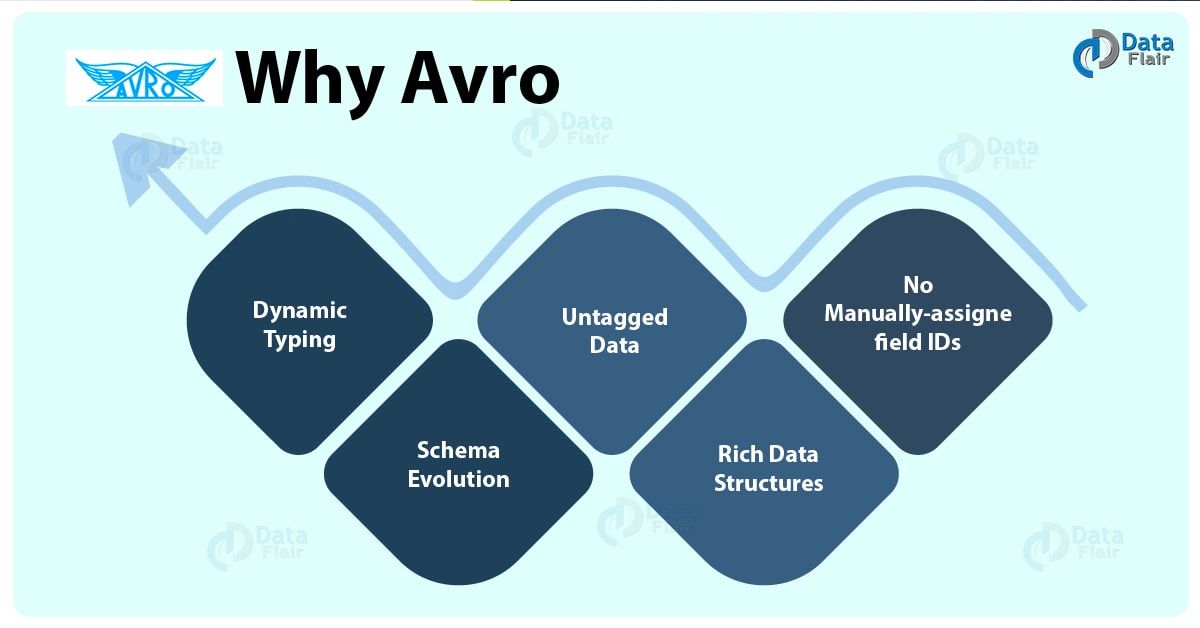Avro Uses | Why Apache Avro is So Popular?
FREE Online Courses: Knowledge Awaits – Click for Free Access!
Today, in this Avro Tutorial, we are going to discuss Avro Uses. Moreover, we will see how to use Apache Avro and when to use Avro. Along with this, we will also look why using Avro and the reasons for the popularity of Apache Avro in Data Serialization.
As we have learned about Avro in its Introductory article, but it is very important to answer these three questions that why when and how to use Avro efficiently. There is a proper way in which we can use Avro.
So, let’s start exploring Avro Uses.
Why Is Avro So Popular?
Below are the reasons that make Apache Avro special. Let’s discuss these Avro Uses in detail:
a. Dynamic Typing
As there is no requirement to generate data in Avro. Here, schema permits full processing of that data even without static datatypes and code generation, hence data is always accompanied. In addition, Avro promotes construction of languages and data-processing systems.
b. Untagged Data
Offering a schema along with binary data permits each datum to be written without the overhead. As a result, faster data processing occurs with more compact data encoding.
c. No Manually-Assigned Field IDs
Both the old and new schema are always present, while schema changes, at the time of processing data, hence by using field names, differences may be resolved symbolically.
d. Schema Evolution
When data is written or read, Avro needs schemas. One of the most interesting facts is we can use different schemas for serialization as well as deserialization purpose. Further, Avro will handle the missing/extra/modified fields.
e. Rich Data Structures
Along with compact, fast, binary data format, Apache Avro offers rich data structures.
How to Use Avro?
There is a specific workflow we need to follow in order to use Avro:
Initiate with creating schemas at first. Then, we are required to design Avro schema as per our data. There is two possible way in which we can read the schemas into our program:
1. Generating a Class Corresponding to Schema
By using Avro, Compile the schema. It helps to generate a class file that corresponds to the schema.
2. Using Parsers Library
Or, by using the parsers library, we can directly read the Avro Schema.
After that, from package org.apache.avro.specific, serialize the data, using the serialization API and then Deserialize the data, using deserialization API from the package org.apache.avro.specific.
Avro Uses: When to Use Avro
Basically, for two things, we use Avro, such as:
- Data serialization
- RPC (Remote procedure call) protocol
However, to understand well, here are some key points:
- By using Avro we are able to read the data from disk with applications written in other languages besides Java or the JVM.
- Also, Avro allows us to transfer data across a remote system without any overhead of java serialization.
- While we need to store the large set of data on disk, we use Avro, since it helps to conserve space.
- Moreover, we get a better remote data transfer throughput using Avro for RPC, since Avro produces a smaller binary output compared to java serialization.
- By using data compression, we get the split ability while rightfully.
- Furthermore, when we want a data container technology that will not need us to keep the data schema separately from the data itself.
- While we need that our data must be splittable on reading by using Hadoop InputFormat classes.
So, this was all in Apache Avro Uses. Hope you like our explanation.
Conclusion: Avro Uses
Hence, we have seen most of Avro Uses, here we can understand Why, when and How to use Avro efficiently in detail. Still, if any doubt regarding Avro Uses, ask in the comment tab. Hope it helps!
Did you like our efforts? If Yes, please give DataFlair 5 Stars on Google


